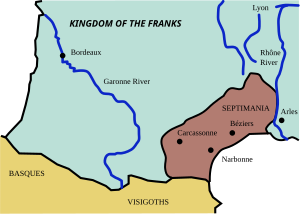
Back Septimanië Afrikaans Septimania AN سبتمانيا Arabic Septimania AST Септыманія Byelorussian Септимания Bulgarian Septimania Breton Septimània Catalan Septimánie Czech Septimanien German

Septimania[1] is a historical region in modern-day southern France.[2] It referred to the western part of the Roman province of Gallia Narbonensis that passed to the control of the Visigoths in 462, when Septimania was ceded to their king, Theodoric II.[2] During the Early Middle Ages, the region was variously known as Gallia Narbonensis, Gallia, or Narbonensis.[3] The territory of Septimania roughly corresponds with the modern French former administrative region of Languedoc-Roussillon that merged into the new administrative region of Occitanie. In the Visigothic Kingdom, which became centred on Toledo by the end of the reign of Leovigild, Septimania was both an administrative province of the central royal government and an ecclesiastical province whose metropolitan was the Archbishop of Narbonne. Originally, the Goths may have maintained their hold on the Albigeois, but if so it was conquered by the time of Chilperic I.[4] There is archaeological evidence that some enclaves of Visigothic population remained in Frankish Gaul, near the Septimanian border, after 507.[4]
The region of Septimania was invaded by the Andalusian Muslims in 719, renamed as Arbūnah and turned into a military base for future operations by the Andalusian military commanders.[5][6] It passed briefly to the Emirate of Córdoba, which had been expanding from the south during the same century, before its subsequent conquest by the Christian Franks in 759,[5][6] who by the end of the 9th century renamed it as Gothia or the Gothic March (Marca Gothica). After the Frankish conquest of Narbonne in 759, the Muslim Arabs and Berbers were defeated by the Christian Franks and retreated to their Andalusian heartland after forty years of occupation, and the Carolingian king Pepin the Short came up reinforced.[5][6] Septimania became a march of the Carolingian Empire and then West Francia down to the 13th century, though it was culturally and politically autonomous from the northern France-based central royal government. The region was under the influence of the people from the count territories of Toulouse, Provence, and ancient County of Barcelona. It was part of the wider cultural and linguistic region comprising the southern third of France known as Occitania. This area was finally brought under effective control of the French kings in the early 13th century as a result of the Albigensian Crusade, after which it was assigned governors. From the end of the thirteenth century Septimania evolved into the royal province of Languedoc.
The name "Septimania" may derive from the Roman name of the city of Béziers, Colonia Julia Septimanorum Baeterrae, which in turn alludes to the settlement of veterans of the Roman Seventh Legion in the city. The name can also be an allusion to the seven cities (civitates) of the territory: Béziers, Elne, Agde, Narbonne, Lodève, Maguelonne, and Nîmes. Septimania extended to a line halfway between the Mediterranean and the river Garonne in the northwest; in the east the Rhône separated it from Provence; and to the south its boundary was formed by the Pyrénées.[2]
- ^ (French: Septimanie [sɛptimani]; Occitan: Septimània [septiˈmanjɔ])
- ^ a b c Jiménez Garnica (2003), pp. 95–105
- ^ Cite error: The named reference
James, 223was invoked but never defined (see the help page). - ^ a b James (1980), p. 236
- ^ a b c Deanesly, Margaret (2019). "The Later Merovingians". A History of Early Medieval Europe: From 476–911. Routledge Library Editions: The Medieval World (1st ed.). London and New York City: Routledge. pp. 244–245. ISBN 9780367184582.
- ^ a b c Collins, Roger (1998). "Italy and Spain, 773–801". Charlemagne. Buffalo, London, and Toronto: Palgrave Macmillan/University of Toronto Press. pp. 65–66. doi:10.1007/978-1-349-26924-2_4. ISBN 978-1-349-26924-2.